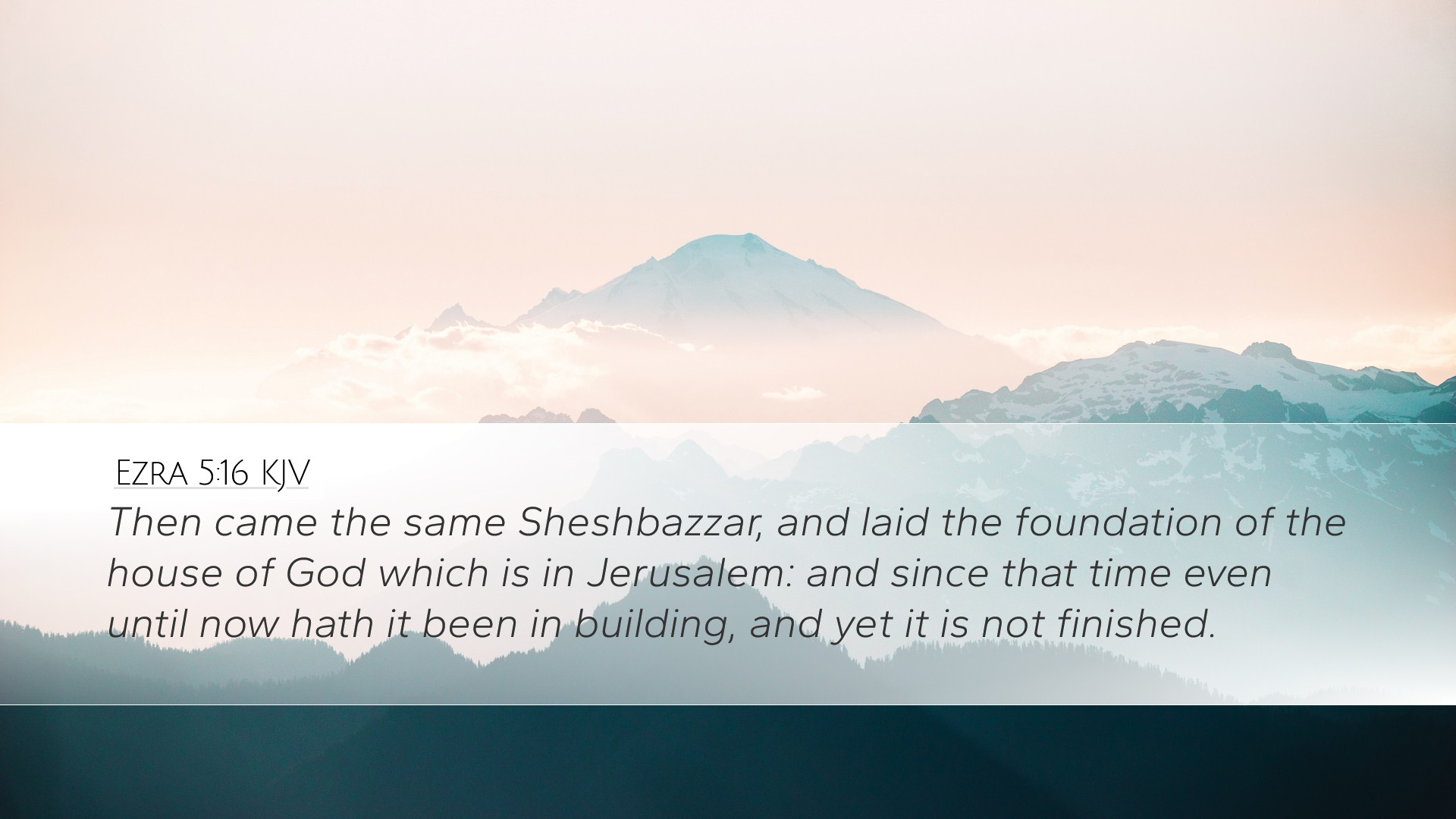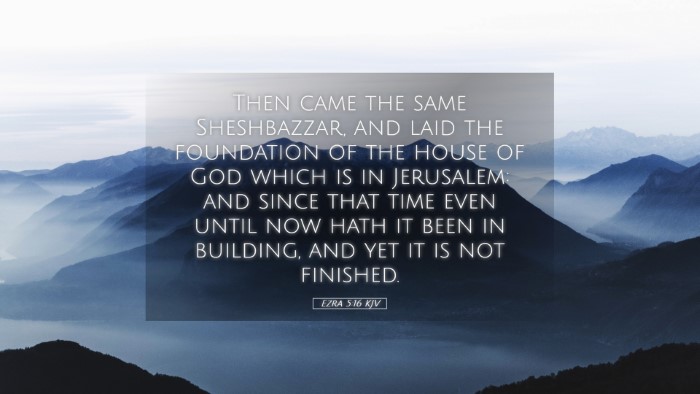Old Testament
Genesis Exodus Leviticus Numbers Deuteronomy Joshua Judges Ruth 1 Samuel 2 Samuel 1 Kings 2 Kings 1 Chronicles 2 Chronicles Ezra Nehemiah Esther Job Psalms Proverbs Ecclesiastes Song of Solomon Isaiah Jeremiah Lamentations Ezekiel Daniel Hosea Joel Amos Obadiah Jonah Micah Nahum Habakkuk Zephaniah Haggai Zechariah MalachiEzra 5:16
Ezra 5:16 KJV
Then came the same Sheshbazzar, and laid the foundation of the house of God which is in Jerusalem: and since that time even until now hath it been in building, and yet it is not finished.
Ezra 5:16 Bible Commentary
Commentary on Ezra 5:16
Verse Context: Ezra 5:16 states, "Then came the same Sheshbazzar, and laid the foundation of the house of God which is in Jerusalem: and since that time even until now hath it been in building, and yet it is not finished." This verse marks a significant moment in the narrative of the restoration of the Jewish temple following the Babylonian exile.
Overview of the Restoration Narrative
The rebuilding of the Temple in Jerusalem signifies a pivotal restoration not only of a physical structure but of the people’s connection to God. Ezra's writings, particularly here, reveal the profound desire of the Jewish people to reclaim their spiritual heritage. The delaying construction serves as a backdrop for spiritual lessons relevant to God's timeline and purposes.
Insights from Commentaries
-
Matthew Henry
Matthew Henry emphasizes the significance of Sheshbazzar's role in the temple's foundation. He notes that the act of laying the foundation in this tumultuous period showcases the resilience and determination of the exiled community to restore their worship. Henry explains how the assertion that the building had "not been finished" illustrates both the challenges they faced and the divine providence at work. It reminds readers of the importance of patience and persistence in God's plans.
-
Adam Clarke
Adam Clarke focuses on the historical context of the construction efforts. He provides insights into Sheshbazzar as a governor and hints at the geopolitical tensions influencing the rebuilding process. Clarke draws readers’ attention to the fact that despite interruptions and opposition, the foundation of the house of God remained a beacon of hope for the Israelites. He also reflects on the theological implications of God's temple as a symbol of His presence among the people, emphasizing the community's need for spiritual renewal.
-
Albert Barnes
Albert Barnes elaborates on the phrase "even until now hath it been in building," which reflects a prolonged struggle. He highlights the discouragement that can emerge when God's promises appear delayed. Barnes situates this commentary within a broader theological discourse about faith, emphasizing that even when physical manifestations of God’s promises seem delayed, believers are called to exercise faith and trust in God’s perfect timing. He also posits the broader implications for the church today, paralleling the historical rebuilding with contemporary challenges in spiritual restoration.
Theological Reflections
The rebuilding of the temple signifies more than a physical act; it is a theological statement about restoration and hope. This verse calls to reflect on several key themes:
- Divine Sovereignty: The construction amidst opposition highlights God’s sovereignty over historical and political circumstances. It encourages readers to trust in His ultimate plans, despite earthly challenges.
- Community and Worship: The act of building the temple underscores the communal aspects of faith. It is a reminder that worship is intrinsic to community identity and restoration.
- Time and Patience: The prolonged effort to finish the temple invites believers to consider the nature of waiting in their faith journey. God’s timelines differ from human expectations, and this tension is part of spiritual growth.
- Hope and Renewal: The unfinished nature of the temple speaks to ongoing renewal in believers' lives and the hope that God continues to restore what is broken.
Application for Today
The message of Ezra 5:16 carries implications for modern audiences, especially pastors, theologians, and students:
- Encouragement in Ministry: For those in ministry, this verse serves as an encouragement to continue their labors, even when results are not immediately evident. Like the exiles, believers are called to remain faithful in their efforts.
- Understanding Delays: It prompts leaders to understand that God’s work often unfolds over time and in ways beyond human comprehension, urging patience and faithfulness in the journey.
- Community Focus: The necessity of community support in spiritual endeavors is underscored. Collaborative efforts in ministry echo the collective rebuilding of the temple.
- Spiritual Growth: The notion that the temple was still "in building" signifies that spiritual growth is an ongoing process. Believers are challenged to continually engage in their faith and community life.
Conclusion
Ezra 5:16 serves as a profound reminder of the intersection between faith, community, and resilience in the face of adversity. Insights from the commentaries encourage readers to appreciate the intricacies of God’s timing while remaining steadfast in their responsiveness to His call. The ongoing nature of the temple's construction resonates deeply with the journey of faith today, where spiritual edifices are still being built within the hearts of believers and the church as a whole.


